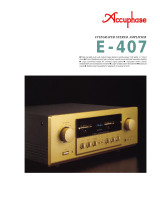
The Voltage Amplifier SV is designed to provide a slew rate of 50 V/us without
entering Class B operation as is common in many other designs. This combined with
excellent high frequency design insures linear operation at high speed, and translates into a
sonic reproduction which is extremely transparent in character. The supplies take a very
direct approach to high performance. First, a top quality toroid transformers and about 10,000
uf of capacitance with very low ESR and inductance is used. Then a clean reference voltage
is heavily filtered and delivered to each stage through independent class A followers which
completely decouples the stages. The resulting non-reactive low impedance over an
extremely wide bandwidth yields a perfect power source. For optimum performance and
reliability all circuitry remains continuously powered. The Current Amplifier S150/250 provides
all of the current gain for the Amplifier System. The specifications are consistent with what
would be expected in a high current Class A amplifier design. In this design, however, an
unusual degree of attention has been paid to sonically meaningful parameters.
The most obvious departure from convention is our design of the front end, or voltage
gain section, and output stage, or current gain section, as separate components. We chose
this path as the ideal solution to a very common source of distortion. Present in virtually all
standard amplifiers to varying degrees is a type of crosstalk between output stages and front
ends. The use of mono amplifiers, and amplifiers using separate power supplies makes the
effect less audible but is only a partial cure, as the sensitive high gain front end remains in
close proximity and thus vulnerable to the radiant effects of the large currents present in the
output stage. By isolating the voltage amplifier from the high current amplifier a superior
signal integrity is maintained.
In the Current Amplifier S150/250 a large number of extremely wide bandwidth output
transistors are used instead of the usual cost effective MOSFET devices which are used in
other transistor designs. A channel of the Current Amplifier S150/250 uses 28/56 individual
transistors with a combined power rating of 3,000 Watts and 240 Amperes with a bandwidth
of 30 mHz.
For example, the current stage is capable of producing peak currents in excess of
100 Amperes with a degree of linearity and speed which is not matched by other designs
when producing only a fraction of this current. This is achieved by the implementation of
several distinct circuit features.
The subtlety of the design process at this level of performance makes it impossible to
easily explain all of the advantages inherent in the Amplifier System. However, we present
here an overview to give you an understanding of some of its unique features and an idea of
the listening experience you can expect. Often a particular technique has numerous
unrelated advantages and possibilities. We make every effort to exploit these advantages
with the final result being an amplifier that is greater than the sum of its individual features.
The Voltage Amplifier SV is designed with the same level of thoroughness usually
reserved for the finest preamplifier voltage gain stages. The topology and component
selection is built on the foundation established by our FET Preamplifiers. Balanced
interconnections are provided to take advantage of their greater noise rejection as in the FET
Preamplifiers. Similarly, all voltage gain is accomplished by FET devices. Differential voltage
gain throughout provides exceptional rejection of external noise and contributes to the
inherent DC stability of the circuit. This allows direct coupling without servo circuitry. The unit
also uses output followers operating without feedback.
DESIGN PHILOSOPHY
8






















